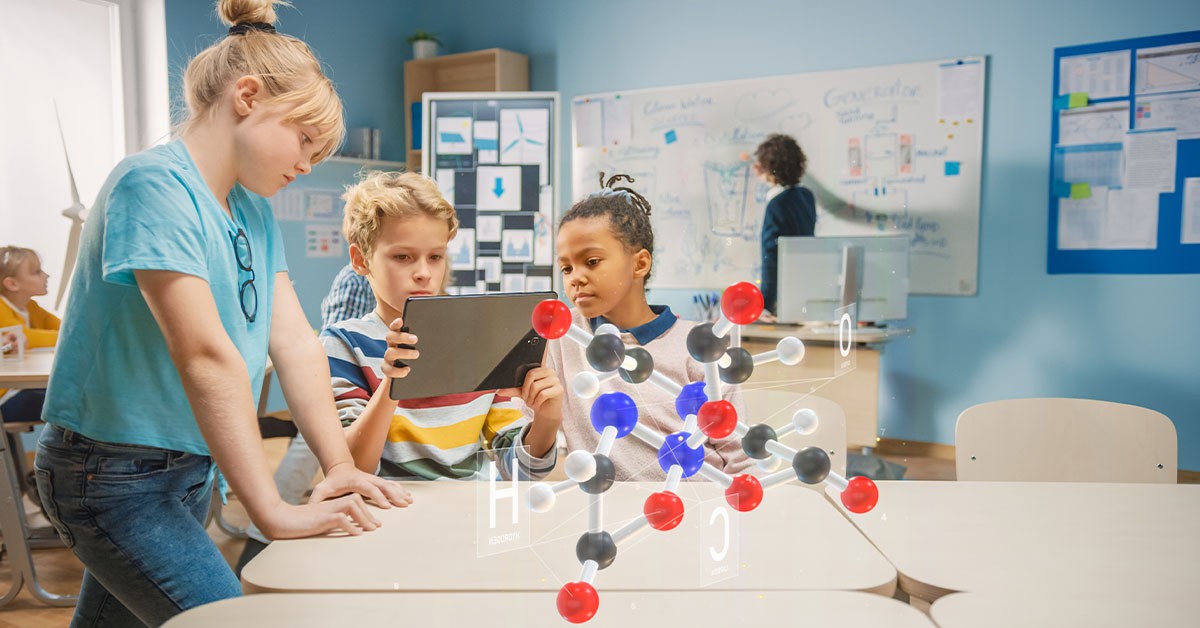
AI-Powered Education: Revolutionizing K12 Learning through Robotics and AI
Summarize with:
With the growing importance of artificial intelligence in our daily lives, it’s no wonder that educational institutions are racing to catch up with the need to leverage intelligent systems that are helping students learn better and achieve their learning objectives.
AI or Artificial intelligence: the ability of a computer program to do human tasks such as thinking and learning: is transforming the concept of both K12 learning and higher education alike. A Technavio report about the AI market in the US education sector also predicts a nearly 48 percent growth rate for AI tools over the next three years.
So, where and how does AI fit into K12 learning?
Let’s explore:
Robotics and AI in K12 Education are becoming increasingly commonplace in schools, largely due to the fact that students in K12 schools will graduate into a highly tech-driven workforce where robots will become widely used in everyday lives.
While individual use cases may vary based on context, effective robotics/AI in education can be grouped into the following general roles:
- Integration: AI solutions can be integrated with other tech initiatives such as IoT-driven networks and smart technology to offer personalized learning solutions for students
- Automation: Robotics, AI, and other technological tools can be used to automate tasks such as grading, timetable scheduling, or digital asset categorization, giving educators more time to engage with students.
- Delineation: AI-driven analytics in education can be used to identify important trends and delineate key markers to help educators design the most effective classroom experiences
- Identification: Data analytics, coupled with smart and adaptive AI solutions, can help in identifying critical areas for both student and teacher performance.
Table of Contents:
- How Can Robotics and AI Tools Be Used in K12 Learning?
- Different Ways to Incorporate Robotics for Education Sectors and Artificial Intelligence in K12 Education
- Introduce AI-Powered Learning Tools
- Bring AI in Educational Robotics to the STEM Curriculum
- Adopt AI for Personalized Assessments
- Putting AI into Educational Robotics Projects
- Leverage Virtual and Augmented Reality with AI
- Use Robotics to Educate Collaborative Problem Solving
- AI-Powered Chatbots as Learning Assistants
- Robotics and AI Competition
- Creating Ethical Awareness About AI
- Educate Teachers on AI and Robotics
- Future Trends of Including Robotics and AI in K12 Education
- AI-based Adaptive Learning in K12 Education
- AI and Robotics-Enabled Gamification of Learning
- AI-Driven Teacher Assistants
- Robotics in the Classroom Setting
- AI-Focused Career Readiness
- Immersive Learning through AI-powered Virtual and Augmented Reality
- Teacher Training and Professional Development in AI and Robotics
- Conclusion
How Can Robotics and AI Tools Be Used in K12 Learning?
Here are five integral ways in which robotics and artificial intelligence in K12 education can revolutionize learning:
1. Individualized Learning
AI can be used to facilitate the application of higher levels of individualized learning through innovative and interactive learning programs. An AI-based educational system allows educators to cater to individual student needs by putting more focus on specific topics and reiterating the areas that the students have not understood clearly.
AI tools also have the ability to identify a student’s strengths and weaknesses to know where they may be struggling. With this information, AI can be used to offer students the required tools they need for success.
Example: Cognii’s AI-based products made for K12 help students by employing conversational technology to guide them in open-format responses that also improve critical-thinking skills. Further, the virtual assistant also provides real-time feedback and one-on-one tutoring and is customized to each student’s individual needs.
2. Customized Curriculum
Apart from helping identify an individual student’s weaknesses, AI tools can also help determine if there are parts of the curriculum that the students are struggling with. This allows educators to take corrective measures and design a customized curriculum as per the learners’ needs.
For example, if a high percentage of students in the classroom get the same question wrong, it allows the teacher to review the learning material and dive into that subject more to ensure that students get a conceptual understanding of the subject. Also, in case there are areas that are more difficult for a teacher, they can utilize supplemental AI teaching tools for better delivery of lessons.
Educational robots programmed to suit each individual’s needs are another way to improve K12 learning, especially for students with special needs. Children with autism, for example, can be supported better by robots in the learning of communication and social skills, interacting with special devices that adapt their answers and responses to students’ reactions.
Example: Nuance makes speech recognition software for students and faculty. The technology can transcribe up to 160 words per minute and is especially helpful for students with limited mobility or ones who struggle with writing.
3. Easing the Workload for Teachers
One of the other ways AI can be used to improve K12 learning is by assisting teachers in mundane administrative tasks like grading assignments, thereby freeing more time to create bespoke lesson plans for each student.
Instead of grading every student’s work individually, which can take up a huge amount of extra time, technology allows teachers the ability to have their students’ work automatically graded with AI tools.
Example: Century Tech is a platform that utilizes data analytics and cognitive neuroscience to create personalized learning plans and reduce workloads for instructors. It is an excellent AI platform that tracks student progress, identifies knowledge gaps, offers personal study recommendations, gives teachers access to resources, and reduces time spent on planning and grading.
4. Collect Meaningful and Immediate Feedback
Besides helping educators craft lessons that are customized to individual student needs, AI tools can also help offer essential feedback to students and teachers on lessons or subjects where improvement is possible. This allows schools to monitor individual students and alert teachers on their areas of weakness.
Further, AI systems can also be used to relay feedback on how to approach the concept in which the students’ weaknesses can be identified and applied together with other methods of learning for better learning outcomes.
Example: Thinkster Math is an excellent tutoring program developed for use on tablets, laptops, and desktops. This K-8 platform combines AI with human interaction to provide students with custom programs. The AI technology helps in tracking work step-by-step and assisting students in understanding where they went wrong or why they are correct.
5. A Robust Technology to Attend School
Educational robotics offers an innovative solution for students who cannot attend school. These robots can be used to bring into the classroom all those students who cannot attend the lessons because of their particular physical conditions.
Whether the student is recovering at home after surgery or has severe allergies restricting him/her from attending school, they can still access a real school experience through a device (personal robot) that attends school and brings the student with it via a dedicated internal video conferencing system.
Example: VGo is a perfect example of a robot that helps students attend school, interact with teachers, chat with friends, and spend the lunch period with them without endangering the student’s health.
Also Read: Role of Artificial Intelligence in Custom Application Development
Different Ways to Incorporate Robotics for Education Sectors and Artificial Intelligence in K12 Education
AI in educational robotics is transforming the face of K12 education. Innovative tools and methods are flooding classrooms to engage students so they learn better. Here are unique ways of artificial intelligence in K12 education to inspire a new generation of innovators:
1. Introduce AI-Powered Learning Tools
AI in K12 education leads to students’ customized learning experiences. There are adaptive learning systems and intelligent tutoring systems, that scan the performance of learners and provide customized lessons to cater to the individual needs of learners.
2. Bring AI in Educational Robotics to the STEM Curriculum
Robotics for education sectors offers students the opportunity to attain hands-on skills, which include coding, engineering, and problem-solving. The inclusion of kits in STEM classes enhances creativity and collaboration among the students.
3. Adopt AI for Personalized Assessments
This artificial intelligence in K12 education can transform the way assessments are carried out by providing a detailed insight into student progress. AI-driven evaluation tools identify weaknesses where students are struggling, enabling teachers to adjust their teaching methods.
4. Putting AI into Educational Robotics Projects
Let students design and code robots using AI algorithms, altogether combining coding, mechanics, and artificial intelligence. These projects ensure a holistic approach to learning and convey a better understanding of technology.
5. Leverage Virtual and Augmented Reality with AI
AI enhances virtual and augmented reality in K12 education. Students can enjoy virtual explorations of the wonders of the world, visualizations of historical landmarks, simulated science experiments, and complex concepts using AI-enhanced VR/AR tools.
6. Use Robotics to Educate Collaborative Problem Solving
The global virtual reality in education market is anticipated to increase from $17.18 billion in 2024 to $65.55 billion by 2032, reflecting a compound annual growth rate of 18.2%. Group activities involving robotics for education sectors can be created to teach teamwork and communication. Designing, building, and programming robots on teams is an excellent group activity that provides the core skills for interpersonal skills.
7. AI-Powered Chatbots as Learning Assistants
AI chatbots in K12 schooling instantaneously help students complete their homework, answer their queries, and guide them through complex topics anytime. These are virtual teaching assistants available 24/7 to support student-independent learning.
8. Robotics and AI Competition
The competition in robotics and AI inspires the students to apply the knowledge they gain in real life. These events motivate the students towards innovation, teamwork, and a sense of accomplishment.
9. Creating Ethical Awareness About AI
K12 education related to the ethical implications of artificial intelligence contributes to the responsible use of artificial intelligence among students. The case of data privacy, algorithmic bias, and social effects of AI make them ready for the next level.
10. Educate Teachers on AI and Robotics
For these technologies to be applied, there is a need to have educators educated to teach AI and robotics. The preparation programs in AI of educational robotics training guarantee teachers the chance to facilitate these technologies effectively across their classrooms.
Future Trends of Including Robotics and AI in K12 Education
Robotics and AI integration in K12 school environments are changing learning futures. Here are key trends leading towards this shift in the education sector and transformation in K12 learning:
1. AI-based Adaptive Learning in K12 Education
AI-based Adaptive learning has emerged as one of the modes through which K12 students can learn information customized according to their speeds and interests. Such tools review the pace at which a student learns and modify the content in real-time. AI offers detailed feedback that helps the student improve specific skills.
2. AI and Robotics-Enabled Gamification of Learning
The gamification trend continues growing, and it learns much and more interactively with the help of AI and robotics. Learning can be even more engaging if robots work as companions or opponents in educational games. To learn new concepts, students earn rewards and badges.
3. AI-Driven Teacher Assistants
AI in K12 is changing the way teachers manage classrooms and instruction with an assistive tool end. AI systems automate grading, schedule-making, and student progress tracking. AI-facilitated virtual teaching assistants assist teachers in lesson plan creation and provide recommendations for individualized activities.
4. Robotics in the Classroom Setting
Robotics now enters the mainstream in the classroom setting, providing students with practical experience with emerging technologies. Dedicated spaces for student robotics and engineering experimentation and learning, are now incorporated into science, technology, engineering, and mathematics curriculum.
5. AI-Focused Career Readiness
The adoption of AI in K12 education is enabling students to prepare for careers with AI. Early certifications in coding, robotics, and AI tools make the student more job-ready. Students learn how AI is applied in the fields of healthcare, finance, and transportation.
6. Immersive Learning through AI-Powered Virtual and Augmented Reality
AI in K12 education has helped to improve upon the VR/AR applications with better immersive learning environments. AI-powered VR technologies allow students to learn about complex topics. AR creates complex scientific experiments into multimedia experiences, making them interactive without heavy equipment.
7. Teacher Training and Professional Development in AI and Robotics
Teachers are on the front lines of successful K12 education applications of AI and robotics. Organizations can conduct workshops as well as courses on AI tools and robotics kits and introduce platforms through which teachers can share best practices as well as resources.
Also Read: Preparing K12 Students for Higher Education: Best Practices
Conclusion
The future of robotics and AI in K12 education is only limited by our imagination and the speed at which technology is evolving. AI-enriched education revolves around tech-driven advanced learning and the job industry; hence, K12 students must adapt to modern, accessible, engaging, and interactive AI-empowered learning.
With the development of more advanced integrated technological solutions, the future holds immense potential for better student experience in K12 learning.
Explore the possibilities in K12 education with Hurix Digital to ensure students’ growth and development. Talk to our experts to revolutionize K12 learning with advanced AI and robotics!
Summarize with:

 Upcoming Masterclass | Build an Army of Brand Evangelists using Training & Development | November 20th, 8:30 AM PDT | 11:30 AM EDT | 10:00 PM IST
Upcoming Masterclass | Build an Army of Brand Evangelists using Training & Development | November 20th, 8:30 AM PDT | 11:30 AM EDT | 10:00 PM IST





